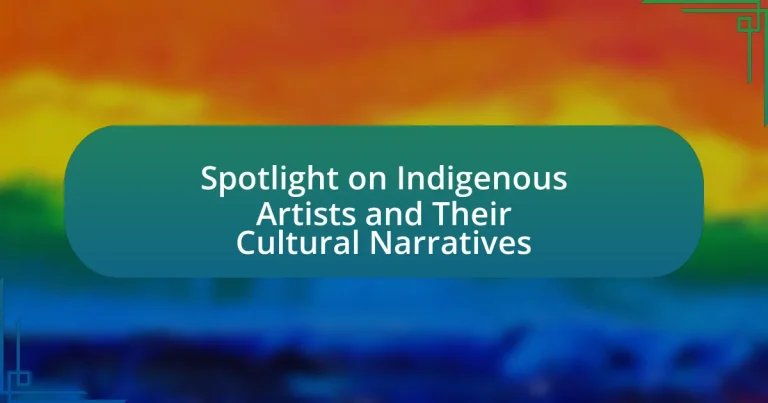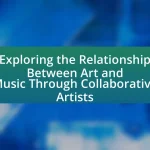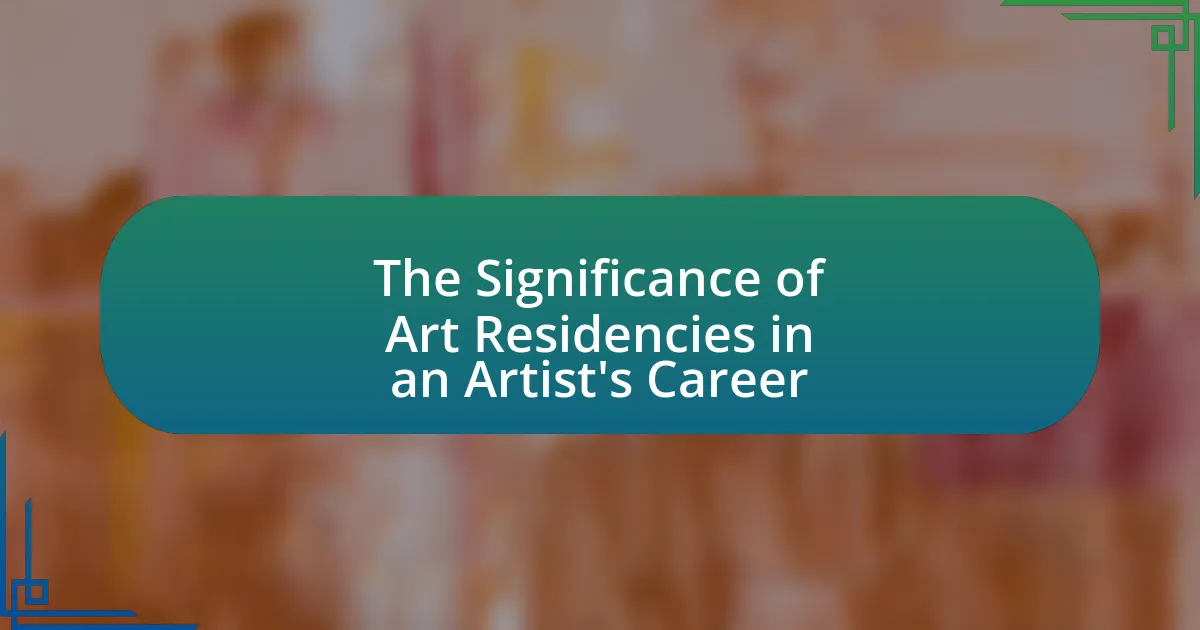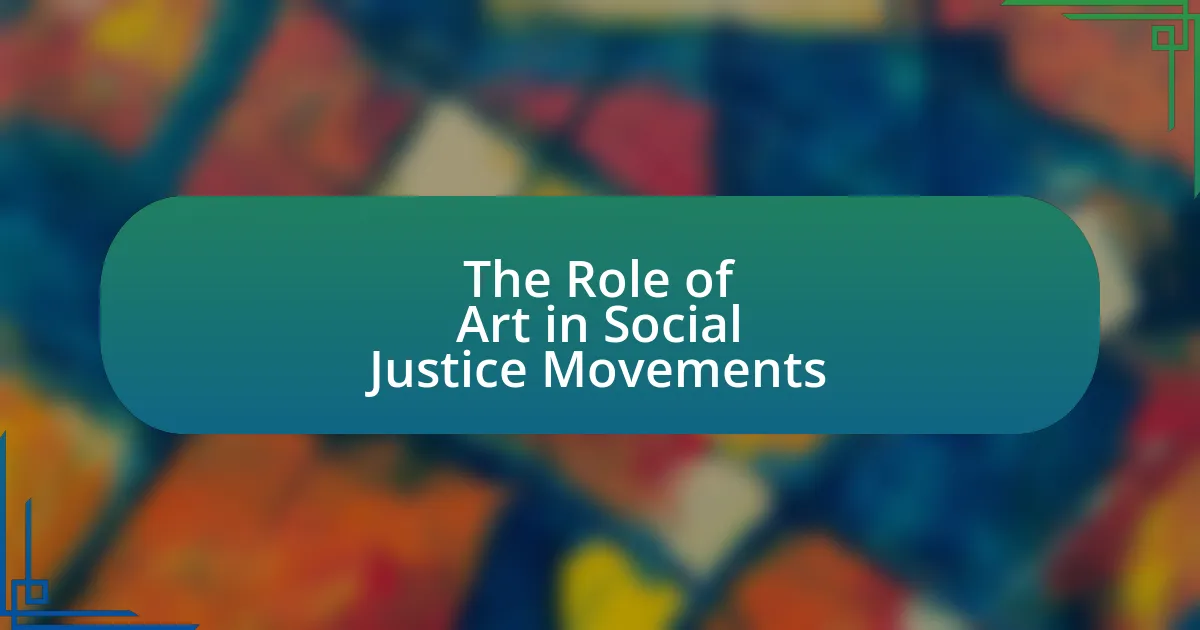Indigenous artists are the original creators of a region, expressing their cultural narratives through various art forms, including painting, sculpture, music, and storytelling. Their work reflects the histories, traditions, and spiritual beliefs of their communities, often addressing contemporary social issues and fostering dialogue between Indigenous and non-Indigenous populations. The article explores how Indigenous artists utilize traditional symbols and techniques to convey their cultural narratives, the challenges they face in the contemporary art world, and the importance of cultural narratives in preserving Indigenous identity. It also discusses initiatives to support Indigenous artists and practical steps individuals can take to appreciate and engage with Indigenous art.
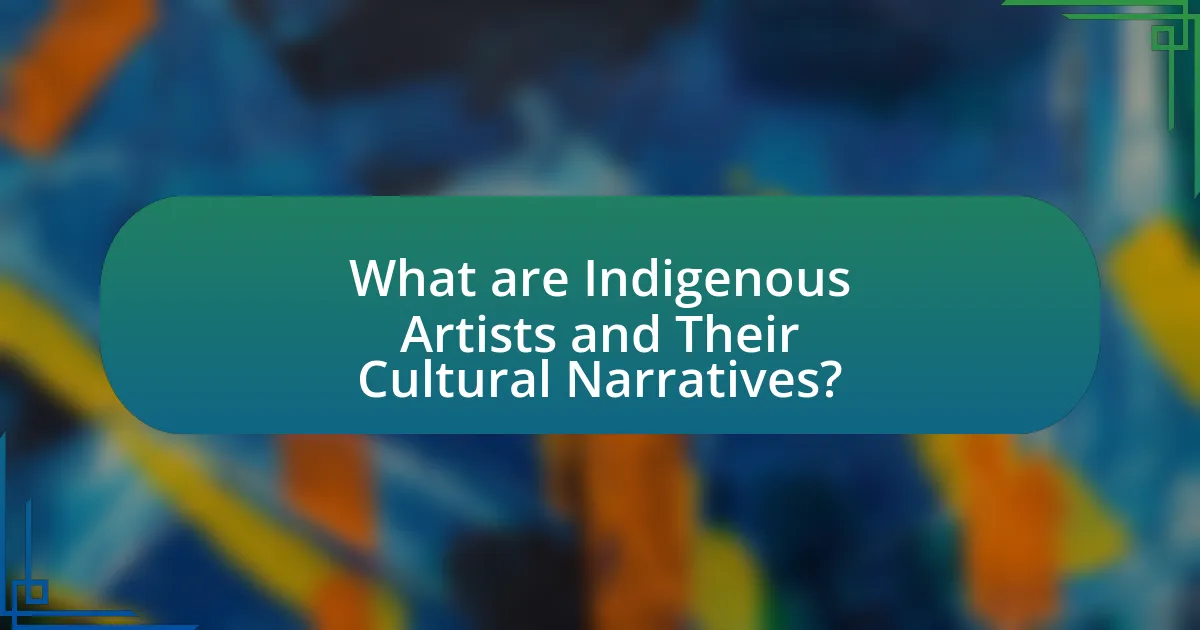
What are Indigenous Artists and Their Cultural Narratives?
Indigenous artists are creators who belong to the original inhabitants of a region, often expressing their cultural narratives through various art forms such as painting, sculpture, music, and storytelling. These artists utilize their work to convey the histories, traditions, and spiritual beliefs of their communities, often reflecting the relationship between their people and the land. For instance, many Indigenous artists incorporate traditional symbols and techniques that have been passed down through generations, which serve as a means of preserving their cultural identity and educating others about their heritage. The significance of their narratives is underscored by the fact that Indigenous art often addresses contemporary social issues, thereby fostering dialogue and understanding between Indigenous and non-Indigenous populations.
How do Indigenous artists express their cultural narratives through their work?
Indigenous artists express their cultural narratives through their work by incorporating traditional symbols, stories, and techniques that reflect their heritage and community values. For instance, many Indigenous artworks utilize motifs and materials that are significant to their specific cultures, such as totem poles in Pacific Northwest art or beadwork in Plains cultures. These elements serve not only as aesthetic choices but also as vehicles for storytelling, preserving oral histories, and conveying spiritual beliefs. Research indicates that Indigenous art often addresses contemporary issues faced by Indigenous communities, thereby bridging the past with the present and fostering a sense of identity and resilience.
What mediums do Indigenous artists commonly use to convey their stories?
Indigenous artists commonly use mediums such as painting, sculpture, weaving, and storytelling to convey their stories. These mediums allow for the expression of cultural narratives, traditions, and histories unique to Indigenous communities. For instance, traditional painting often incorporates symbols and motifs that reflect spiritual beliefs and ancestral connections, while weaving can represent community ties and resourcefulness. Additionally, oral storytelling remains a vital medium, preserving and transmitting knowledge across generations.
How do traditional techniques influence contemporary Indigenous art?
Traditional techniques significantly influence contemporary Indigenous art by providing a foundation of cultural identity and authenticity. Many contemporary Indigenous artists incorporate traditional methods, such as weaving, carving, and painting, to connect their work to ancestral practices and narratives. For instance, artists like Eliza McCausland utilize traditional weaving techniques to create modern pieces that reflect Indigenous stories and values, thereby preserving cultural heritage while engaging with contemporary themes. This blending of old and new not only honors the past but also allows for the evolution of Indigenous art in a modern context, ensuring that these cultural expressions remain relevant and impactful.
Why are cultural narratives important in Indigenous art?
Cultural narratives are important in Indigenous art because they serve as a means of preserving and transmitting the history, beliefs, and values of Indigenous communities. These narratives encapsulate the unique experiences and worldviews of Indigenous peoples, allowing artists to express their cultural identity and heritage through visual storytelling. For instance, many Indigenous artworks incorporate symbols and motifs that reflect ancestral knowledge and spiritual connections to the land, which are integral to the community’s cultural narrative. This artistic expression not only fosters a sense of belonging and continuity among Indigenous peoples but also educates broader audiences about their rich cultural legacies, thereby promoting understanding and respect for Indigenous histories and perspectives.
What role do cultural narratives play in preserving Indigenous identity?
Cultural narratives play a crucial role in preserving Indigenous identity by transmitting values, beliefs, and histories across generations. These narratives, often conveyed through storytelling, art, and oral traditions, serve as a means of maintaining cultural continuity and fostering a sense of belonging within Indigenous communities. For instance, the oral traditions of the Navajo people encapsulate their cosmology and social values, reinforcing their identity and connection to the land. Research indicates that such narratives not only strengthen community ties but also empower individuals by affirming their cultural heritage in the face of external pressures and assimilation efforts.
How do these narratives reflect the history and experiences of Indigenous communities?
Narratives from Indigenous artists reflect the history and experiences of Indigenous communities by encapsulating their cultural heritage, struggles, and resilience. These narratives often address historical injustices, such as colonization and land dispossession, which have profoundly impacted Indigenous identities and ways of life. For instance, many Indigenous artworks depict traditional practices, oral histories, and spiritual beliefs, serving as a means of preserving and transmitting cultural knowledge across generations. Additionally, these narratives frequently highlight contemporary issues faced by Indigenous peoples, such as social inequality and environmental challenges, thereby fostering awareness and dialogue about their ongoing struggles. This connection between art and lived experience underscores the importance of Indigenous voices in reclaiming their narratives and asserting their place in history.
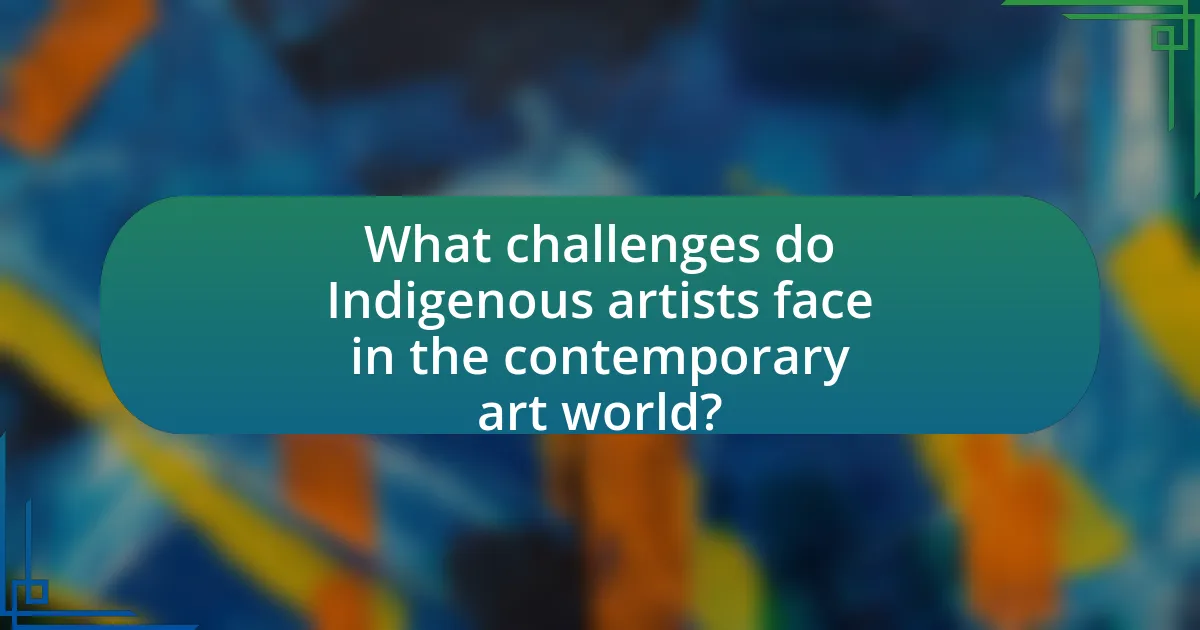
What challenges do Indigenous artists face in the contemporary art world?
Indigenous artists face significant challenges in the contemporary art world, including cultural appropriation, lack of representation, and limited access to funding and resources. Cultural appropriation occurs when non-Indigenous individuals or institutions exploit Indigenous art and symbols without understanding their significance, undermining the artists’ cultural narratives. Additionally, Indigenous artists are often underrepresented in galleries and exhibitions, which restricts their visibility and opportunities for recognition. According to a 2020 report by the Canada Council for the Arts, Indigenous artists receive only a fraction of the total funding available for the arts, further exacerbating their challenges in accessing necessary resources to create and promote their work.
How does cultural appropriation impact Indigenous artists?
Cultural appropriation negatively impacts Indigenous artists by undermining their cultural heritage and economic opportunities. When non-Indigenous individuals or entities adopt Indigenous cultural elements without permission or understanding, it often leads to misrepresentation and commodification of their art and traditions. For instance, Indigenous artists frequently face challenges in protecting their intellectual property, as seen in cases where their designs are reproduced by mainstream fashion brands without consent, resulting in financial losses and diminished cultural significance. This appropriation not only disrespects the original context of the art but also perpetuates stereotypes, further marginalizing Indigenous voices in the creative industry.
What are the consequences of misrepresentation in Indigenous art?
Misrepresentation in Indigenous art leads to cultural appropriation, loss of authenticity, and economic harm to Indigenous artists. Cultural appropriation occurs when non-Indigenous individuals exploit Indigenous symbols and styles without understanding their significance, diluting their meaning and context. This undermines the cultural narratives that Indigenous artists aim to convey, resulting in a misrepresentation of their heritage. Additionally, economic harm arises when non-Indigenous entities profit from these misrepresentations, depriving Indigenous artists of rightful recognition and financial benefits. For instance, a study by the Australian Institute of Aboriginal and Torres Strait Islander Studies highlights that unauthorized reproductions of Indigenous art can significantly impact the livelihoods of Indigenous creators, illustrating the tangible consequences of misrepresentation.
How can Indigenous artists reclaim their narratives in the face of appropriation?
Indigenous artists can reclaim their narratives in the face of appropriation by actively engaging in the creation and promotion of their own cultural expressions. This involves utilizing traditional art forms and storytelling methods to assert their identities and histories, thereby countering misrepresentation. For instance, the use of social media platforms allows Indigenous artists to share their work directly with audiences, bypassing traditional gatekeepers in the art world. Additionally, initiatives like the Indigenous Art Code promote ethical practices in the art market, ensuring that Indigenous creators are recognized and compensated for their contributions. These strategies empower Indigenous artists to control their narratives and challenge appropriation effectively.
What barriers exist for Indigenous artists in gaining recognition?
Indigenous artists face significant barriers in gaining recognition, primarily due to systemic racism, lack of access to funding, and cultural appropriation. Systemic racism manifests in the art industry through biased perceptions and limited opportunities for Indigenous representation in galleries and exhibitions. Additionally, funding disparities hinder Indigenous artists from accessing resources necessary for their development and visibility. Cultural appropriation further complicates recognition, as non-Indigenous artists often exploit Indigenous themes without proper acknowledgment or compensation, overshadowing the original creators. These factors collectively contribute to the ongoing challenges Indigenous artists encounter in achieving recognition for their work.
How do funding and support systems affect Indigenous artists’ visibility?
Funding and support systems significantly enhance Indigenous artists’ visibility by providing essential resources and platforms for their work. These systems enable access to grants, exhibitions, and mentorship programs, which are crucial for promoting Indigenous art and culture. For instance, organizations like the Canada Council for the Arts allocate funding specifically for Indigenous artists, resulting in increased representation in galleries and festivals. This financial backing not only elevates individual artists but also fosters a broader appreciation of Indigenous narratives within the art community, as evidenced by the rise in attendance at events showcasing Indigenous art following such funding initiatives.
What initiatives are in place to support Indigenous artists and their narratives?
Various initiatives exist to support Indigenous artists and their narratives, including government grants, cultural programs, and community organizations. For instance, the Canada Council for the Arts provides funding specifically for Indigenous artists through programs like the Indigenous Arts Program, which aims to promote and support Indigenous cultural expressions. Additionally, organizations such as the First Peoples’ Cultural Council in British Columbia offer resources and funding to help Indigenous artists develop their work and share their stories. These initiatives are designed to empower Indigenous voices and preserve cultural heritage, ensuring that their narratives are recognized and celebrated within the broader artistic community.
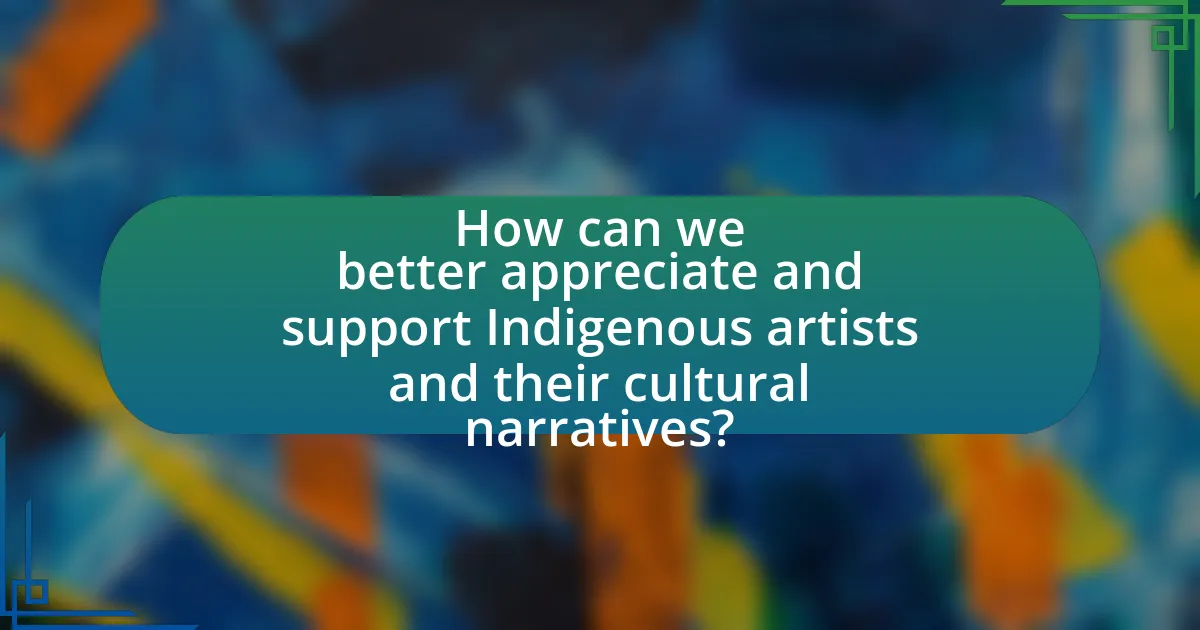
How can we better appreciate and support Indigenous artists and their cultural narratives?
To better appreciate and support Indigenous artists and their cultural narratives, it is essential to actively engage with their work and promote their visibility in mainstream platforms. This can be achieved by prioritizing the inclusion of Indigenous artists in galleries, festivals, and public art projects, which fosters a greater understanding of their cultural significance. Research indicates that Indigenous art contributes to cultural preservation and community identity, as seen in studies like “Indigenous Art and Cultural Identity” by the Australian Institute of Aboriginal and Torres Strait Islander Studies, which highlights the role of art in expressing and maintaining cultural narratives. Additionally, providing financial support through grants and commissions specifically for Indigenous artists can empower them to create and share their stories, ensuring that their voices are heard and valued in the broader cultural landscape.
What are effective ways to engage with Indigenous art and artists?
Effective ways to engage with Indigenous art and artists include attending cultural events, supporting Indigenous art markets, and participating in workshops led by Indigenous creators. Attending events such as powwows or art exhibitions allows individuals to experience the art in its cultural context, fostering a deeper understanding. Supporting Indigenous art markets directly contributes to the economic sustainability of Indigenous artists and communities. Participating in workshops provides hands-on experience and insight into traditional techniques and cultural significance, enhancing appreciation for the art form. These methods not only promote awareness but also respect and honor Indigenous cultural narratives.
How can art institutions promote Indigenous narratives in their programming?
Art institutions can promote Indigenous narratives in their programming by actively collaborating with Indigenous artists and communities to ensure authentic representation. This collaboration can include co-curating exhibitions that highlight Indigenous histories, traditions, and contemporary issues, thereby providing a platform for Indigenous voices. For instance, the National Museum of the American Indian has successfully implemented programs that feature Indigenous perspectives, showcasing the importance of cultural context in art. By integrating educational workshops and community engagement initiatives, art institutions can further deepen understanding and appreciation of Indigenous cultures, fostering a more inclusive narrative within the art world.
What role does education play in fostering appreciation for Indigenous art?
Education plays a crucial role in fostering appreciation for Indigenous art by providing knowledge about its cultural significance and historical context. Through educational programs, students learn about the diverse traditions, stories, and techniques that characterize Indigenous art, which enhances their understanding and respect for these cultural expressions. For instance, curricula that include Indigenous perspectives and artists can lead to increased awareness and appreciation, as evidenced by studies showing that students exposed to Indigenous art history demonstrate greater empathy and cultural sensitivity. This educational approach not only enriches the appreciation of Indigenous art but also promotes a broader understanding of the cultural narratives that shape Indigenous identities.
What practical steps can individuals take to support Indigenous artists?
Individuals can support Indigenous artists by purchasing their artwork directly from them or through Indigenous-owned galleries. This practice ensures that a larger portion of the proceeds goes to the artists themselves, rather than intermediaries. Additionally, individuals can promote Indigenous art by sharing it on social media platforms, which increases visibility and appreciation for the artists’ work. Engaging in workshops or events led by Indigenous artists also fosters a deeper understanding of their cultural narratives and provides financial support. Supporting initiatives and organizations that advocate for Indigenous rights and arts can further amplify their voices and contributions to the cultural landscape.
How can consumers make informed choices when purchasing Indigenous art?
Consumers can make informed choices when purchasing Indigenous art by researching the artist’s background, understanding the cultural significance of the artwork, and verifying the authenticity of the piece. Researching the artist involves looking into their heritage, community ties, and previous works, which can provide insight into the cultural narratives they represent. Understanding the cultural significance requires knowledge of the symbols, materials, and techniques used in the artwork, as these often reflect Indigenous traditions and stories. Verifying authenticity can be achieved by seeking certificates of authenticity, provenance documentation, or purchasing from reputable galleries that specialize in Indigenous art, ensuring that the art supports the artists and their communities.
What are the best practices for collaborating with Indigenous artists?
The best practices for collaborating with Indigenous artists include establishing respectful relationships, ensuring fair compensation, and honoring cultural protocols. Respectful relationships involve understanding and valuing the artist’s cultural background and perspectives, which fosters trust and collaboration. Fair compensation is crucial, as it acknowledges the artist’s work and contributions, aligning with ethical standards in the creative industry. Honoring cultural protocols means recognizing and adhering to the specific customs and practices of the Indigenous community, which can vary widely. For instance, the First Peoples’ Cultural Council emphasizes the importance of consent and collaboration in their guidelines for working with Indigenous artists, highlighting that these practices not only support the artists but also enrich the collaborative process.
